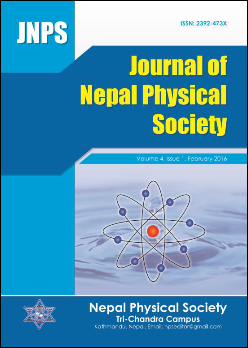A Study of Dust Structure around AGB Star in 60 and 100 μm IRAS Survey at Latitude 54.68º
DOI:
https://doi.org/10.3126/jnphyssoc.v4i1.17339Keywords:
AGB Stars, Low and intermediate mass stars, Dredge-up, Thermal pulse, Nucleosynthesis, S-process, Mass loss, Excess massAbstract
We have studied about the evolution of Asymptotic Giant Branch (AGB) stars, mass losses from them and a systematic search of AGB stars in J2000 coordinate system provided by K. W. Shu & Y. J. Kwon (2011) of dust structure in the far infrared range (100 μm and 60 μm). For dust structure IRAS survey was performed using Sky View virtual Observatory. The FITS images downloaded from sky view was processed using software Aladin v 2.5. A cavity like structure (major diameter∼1.93 pc & minor diameter∼ 0.89 pc) lies in the coordinate of R. A. (J2000) 04h 15m 03s and DEC (J2000) 54d 41m 00s was found at the distance∼ 240 pc. We studied the flux density variation and the temperature variation about major diameter, minor diameter and the distance between minimum temperature and minimum flux within the structure. We observed the variation of the temperature is 20.53 K to 21.09 K, with the offset of about 0.56 K, which show the cavity is independently evolved. The mass profile of each pixel of the structure was also calculated using this temperature.
Journal of Nepal Physical Society
Volume 4, Issue 1, February 2017, Page: 67-77
Downloads
Downloads
Published
How to Cite
Issue
Section
License
All right reserved. No part of this Journal may be reproduced in any form or by any electronic or mechanical means, including information storage and retrieval system, without permission in writing from the publisher, except by a reviewer who may quote brief passage in a review. The views and interpretation in this journal are those of author(s) and they are not attributable to the NPS.




